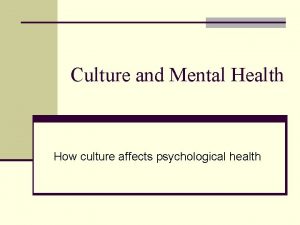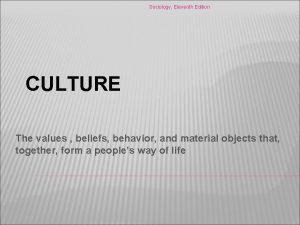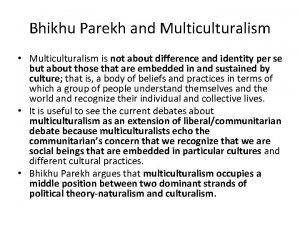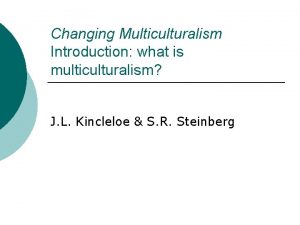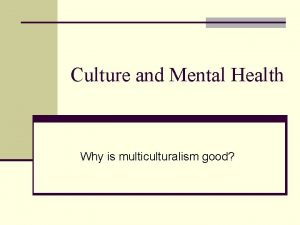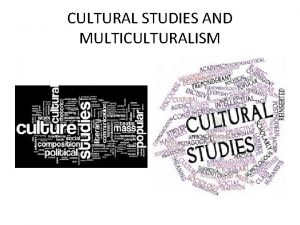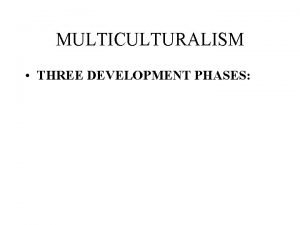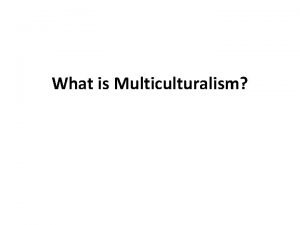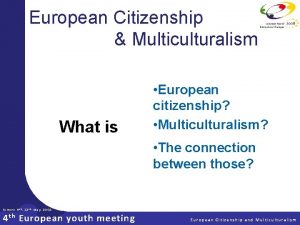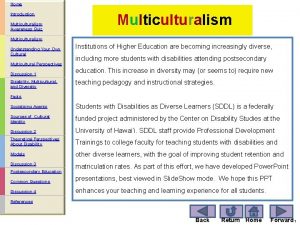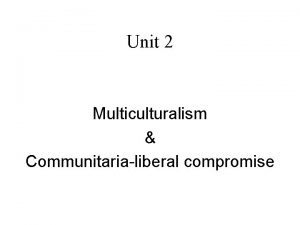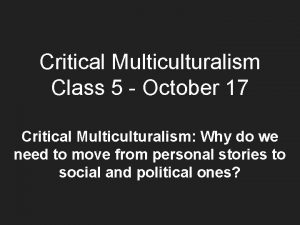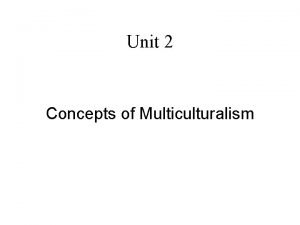Culture and Mental Health Why is multiculturalism good





















- Slides: 21

Culture and Mental Health Why is multiculturalism good? or The hidden assumptions about mental health and its treatment

In this lecture… 1. The limitations of the DSM 2. An alternative approach 3. Cultural Competence • should we focus on race, class, and culture in therapy? • therapist ideology and its implications for psychotherapy • a multicultural orientation

The assumptions of the DSM Four basic psychological paradigms n n Psychodynamic Cognitive-Behavioral Humanistic Biological What assumptions do they share about the etiology of abnormal behavior and mental health problems?

The assumptions of the DSM (cont. ) Assumption 1: The problem is in the person (or family) Assumption 2: The appropriate intervention is to treat the person (or his/her family) Why might this be problematic?

Four steps to “blaming the victim” William Ryan 1971, 1976 1. Identify a social problem 2. Study those affected by the problem to discover how they are different from those who are not affected by the problem. 3. Define the difference as the cause of the problem itself 4. Create a humanitarian action (social service) program to correct the differences (from #2)

Therapeutic implications of “blaming the victim” n Implication 1: Environmental factors are often ignored or minimized in assessment and treatment n Implication 2: Some individuals are more likely to be negative affected by implication 1 than others Who is likely to be disproportionally affected?

Urie Bronfenbrenner Alternative Approach: Attend to environmental aspects in both assessment and intervention Often misrepresented Ecology from Ecos: House (Greek) Ecology: A House in Biological Terms A system of interacting organisms

Therapeutic implications of ecological model n Psychopathology, even individual psychopathology can only be understood within the context of a person’s family, community, and sociocultural environment. These may differ according to client’s n n n gender race/ethnicity/culture/religion immigration status sexual orientation socioeconomic status n Given above, a client’s “psychopathological” behavior: n n may be influenced by therapist’s attitudes regarding client’s demographic characteristics may not actually violate cultural norms and thus not “pathological” may be driven by society’s deficits, rather than the client’s may be treated more appropriately and efficiently through community interventions

Cultural Competence n What is Cultural Competence? It’s not easily defined, but what might it entail? What might it NOT entail?

The fundamental question vis a vis psychotherapy: Should we focus on race, ethnicity, and culture in therapy? Two “good” arguments not to: 1. We are all fundamentally the same 2. Each of us is a unique person with unique life experiences On the other hand: "I don’t see color, I only see children. ” What message does this statement send? That there is something wrong with black or brown, that it should not be noticed? I would like to suggest that if one does not see color, then one does not really see children. Children made “invisible” in this manner become hard- pressed to see themselves worthy of notice. ” Lisa Delpit

Assumptions of multiculturalism n Diversity (of all sorts) is valuable and should be pursued n n n Group differences should be recognized Group differences should be respected Group differences should be valued

Three dimensions of cultural competence (Sue et al. , 1998) 1. Therapist is aware of own assumptions, values, and biases • role that race/ethnicity/culture plays in own life • role that race/ethnicity/culture plays in mental health • role that race/ethnicity/culture plays in psychotherapy 2. Therapist focuses on understanding the racial ideology and worldview of culturally different clients • how client(s) perceive mental health and psychotherapy • how client(s) perceive therapist 3. Therapist develops appropriate counseling strategies and techniques

Racial ideology Left Right Theoretical center Where do you think you are? Where do you think “liberals” are? Where do you think “conservatives” are?

Racial ideologies Mainstream U. S. ideology Multicultural Left Right Radical Liberal Neo-lib. Neo-con. Conservative Racism so deeply embedded in our structures that reform not possible. New structures must be created. Race is socially constructed. The path to equality is race-based remedy Fascist Race is socially constructed. The path to equality is a color-blind society. Race is biologically determined and people generally get what they deserve (a just world) Race is socially constructed. The path to equality is need-based remedy Since God created racial differences, racial inequality is both normal and desirable, and it is God’s will that the White race be in “control. ”

Racial Ideologies (samples) n Neo-Conservative: “My proposal for dealing with the racial issue in social welfare is to repeal every bit of legislation and reverse every court decision that in any way requires, recommends, or awards differential treatment according to race…We may argue about the appropriate limits of government intervention in trying to enforce the ideal, but at least it should be possible to identity the ideal: Race is not a morally admissible reason for treating one person differently from another. Period. ” Charles Murray, “Losing Ground: American Social Policy, 1950 -1980” n Liberal: “A profound difference separates governmental actions that themselves are racist and governmental actions that seek to remedy the effects or prior racism or to prevent neutral government activity from perpetuating the effects of such racism. ” Supreme Court Justice, Thurgood Marshall

The culturally competent therapist (cont. ) n Is cognizant of cultural explanations of phenomena n The behaviors displayed may not be considered maladaptive or abnormal in the other culture. n There may be a cultural explanation for the client’s experiences n Experience of racism and prejudice may account for certain beliefs/behaviors n Talking to a therapist is a very “cultural” experience that may take considerable adjustment and trust-building for some clients. n Avoids oversimplified cultural explanations For example, the idea of collectivism vs. individualism is a broad dichotomy. In reality, these differences lie on a continuum…with not only variation between cultural groups but also within cultural groups.

The culturally competent therapist (cont. ) n Avoids making assumptions n Each client is an individual, not a stereotype. Be careful about what you think you know about a person given their cultural background n n n Acculturation: Psychosocial change that occurs when a group or individual comes into continuous first-hand contact w/ another culture All cultural “facts” should be treated as hypotheses Do not prejudge which aspects of a client's cultural history, values, and lifestyle are relevant to your work with the client. A person’s racial, ethnic, and even cultural background does not necessarily tell us anything important in and of themselves. n n Do not assume that client values either cultural assimilation or maintenance of traditional cultural beliefs/practices. Acculturation preferences should be assessed Experiences of prejudice/discrimination may or may not be salient for the client. Racial and/or ethnic identity should be assessed.

The culturally competent therapist (cont. ) n Works with a multicultural orientation n n Recognizes that culture is there and values cultural differences Understands that cultural differences can trigger important discussions that not only have therapeutic benefit but also educate both client and therapist and, in so doing, break down stereotypes Looks for personal and cultural strengths and tailors intervention so that is consistent with client’s cultural values and strengths Seeks to assist the client in identifying areas that create social or psychological conflict related to bi-culturalism and seeks to reduce dissonance in those areas Is prepared to deal with situations when the client’s culture seriously clashes with the values/beliefs of therapist (cultural relativism) Fowers & Richardson (1996) assert that therapist can choose to reject the questionable behaviors of the other culture. However, this is contingent upon therapist first having an accurate and relatively complete perspective on the client’s culture, from that culture’s own point of view.

Legitimate criticism of Multiculturalism n Conservative n Multiculturalism is a form of cultural relativism, and some cultural practices are morally repugnant n Multiculturalism is a rejection of majority culture n Multiculturalism encourages cultural separatism n Neo-Conservative n We are really all fundamentally the same n We all fundamentally different n Liberal n Multiculturalism is a form of cultural relativism, and some cultural practices are morally repugnant (same as conservatives) n Multiculturalism is a rejection of majority culture (same as conserv. ) n Radical n Multiculturalism does not acknowledge power dynamics n True multiculturalism is unattainable because of power differential n Multiculturalism may threaten the “authenticity” of a group through contact with other cultures.

An example from the past n Earlier in the course we saw Gina – an African American woman – interact with two White male therapists. n Would therapist have been more effective in this particular case if he had paid more attention to Gina’s cultural identity and background? n If so, what might a therapist do to display appropriate cultural competence?

Cultural Competence Continuum Cultural Destructiveness Cultural differences are seen as problematic. Goal of therapy is to eliminate cultural differences. Cultural Incapacity Although they do not intentionally seek to cause harm, individuals in this stage believe in the superiority of their own racial or ethnic group and assume a paternalistic posture toward “lesser” groups. Cultural Blindness Color or culture is assumed to make no difference and all people are assumed to be fundamentally the same. Cultural Pre-competence Weaknesses in working with various cultures are acknowledged and some effort made to improve services to diverse populations. Cultural Competence Cultural differences are accepted and respected. Therapists engage in continuing cultural self-assessment. Cultural Proficiency Culturally proficient individuals prioritize cultural competency in their clinical work, research, teaching, etc.
 Chapter 20 mental health and mental illness
Chapter 20 mental health and mental illness Hey bye bye
Hey bye bye Mental health coping skills jeopardy
Mental health coping skills jeopardy Influence of culture on mental health
Influence of culture on mental health Multiculturalism pros and cons
Multiculturalism pros and cons Multiculturalism sociology
Multiculturalism sociology Multiculturalism definition
Multiculturalism definition Examples of multiculturalism
Examples of multiculturalism Types of subcultures
Types of subcultures Bhikhu parekh multiculturalism upsc
Bhikhu parekh multiculturalism upsc Mr stepek ap human geo
Mr stepek ap human geo Changing multiculturalism
Changing multiculturalism Monument to multiculturalism
Monument to multiculturalism Multiculturalism ap human geography
Multiculturalism ap human geography Critical multiculturalism definition
Critical multiculturalism definition Multiculturalism definition
Multiculturalism definition Multiculturalism
Multiculturalism Zoroastrian good thoughts
Zoroastrian good thoughts Hi, good evening
Hi, good evening Buenas tardes good afternoon
Buenas tardes good afternoon You are good you are good when there's nothing good in me
You are good you are good when there's nothing good in me Good evening students
Good evening students



